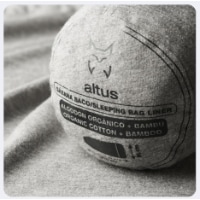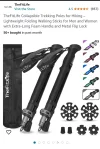My take on this is that you get what you pay for, particularly if you are going to be using your poles continually and are serious about either reducing the weight being carried through your hips and knees, or improving your walking speed.
My own experience with cheaper poles was on the CF, where one of a set of poles in the mid-price range at the time had lost the metal tip, and the rest of the tip was being destroyed as the plastic was no longer protected when it was hitting the ground. I bought a cheap pair in Villafranca. They were sprung poles, but only for a few days when the spring in one pole collapsed completely. The other lasted a couple more day. I bought a more expensive, still mid-price range, pair in Melide. These lasted the rest of the camino, but failed within about six months of regular use back home when the twist lock failed on one pole.
Losing the spring is not an uncommon failure mechanism, and I have had such failures on other poles. The major difference is that poles from reputable makers like Komperdell, Black Diamond and Leki have always given a much longer life than mid-range brands like Fizan. Some years ago Black Diamond made poles with a 'rubber' ring between the handgrip and top pole section as the spring. The one I have has lasted in regular use for over a decade. This approach doesn't seem to have been continued. My lesson from this is that I avoid buying anti-shock poles.
Another area where cheaper pole brands appear to cut costs is in the strap design. The first way they do this is by reducing the width of the strap. This will make the strap less comfortable as it will reduce the surface area of strap around the wrist, increasing the pressure on the skin for any particular downward pressure on the pole. Leki and Black Diamond have straps about 3cm wide. I find anything much less than 2.5cm wide noticeably less comfortable.
The next area of strap design is the materials used. This starts with simple, relatively hard, webbing straps with plastic buckles. Some makers use a softer strap, trim the edges with a softer material, or line the strap where it fits around the wrist, all to make the strap more comfortable to use. The other approach that has emerged over recent years is a very thin, wide strap made of a slightly softer but still strong material. I have had a couple of pairs of Leki poles with this arrangement. They have been improving this system, and on the most recent Leki poles I purchased this year, it has been improved significantly. With the earlier poles, the strap had a tendency to twist and not sit flat around my wrist under some usage conditions.
Then there is a wide variety of strap adjustment mechanisms, even with poles from the same maker there can be variations. Some simpler mechanisms will reduce the weight, but have other design compromises that make them more difficult to adjust easily. I find the current Leki mechanism one of the best for ease of use, followed by any mechanism that uses a small wedge in the handle to tighten the strap. I don't particularly like those with simple plastic buckles that sit at the back of the wrist or along the side of the hand. In between are those, like Fizan, that use a velcro adjustment that works reasonably well.
Collapsing vs folding poles. I don't think there is much in this for a lot of people, and on the Camino, I don't think it makes much difference. I use collapsing poles because I walk in conditions where there are regularly steep downhill slopes, and I want to extend my poles far more than the relatively limited range provided by the foldable poles I have seen. Suffice to say for the camino, either approach should work.
Carbon vs aluminium. I have used both, and I do like the lightness of good carbon poles, but I don't really think that the extra cost is worth it.
Flick lock vs twist locks. I prefer a flick lock for the ease of making adjustments to my pole length as I transition from flat and uphill to steeper downhill. Twist locks take a little more time to adjust, and are better suited to flatter terrain or places where one setting will suffice for most of the walk. Flick locks will need to be kept tight in order to work, an adjustment that is a matter of moments once you know how to do it. I see some comments earlier that indicate this wasn't done, and the pole kept collapsing. That is entirely preventable.
Rubber tips, baskets, and other fittings. I leave the mud basket on all my poles. This is not a matter of aesthetics, but as a practical matter I do use my poles walking on wet tracks and over soft soil where the mud basket prevents the pole sinking too far. Perhaps not a bit issue for most camino routes. Rubber tips on the other hand are a no brainer. Use good ones - Black Diamond or Forclaz (Decathalon) are my current choices for good, long lasting 'conical' tips, and Swix for good walking tips*. My recent experience with other makers tips has not been great. I did find a really good solid tip when I did the S:t Olavsleden a few years ago, but haven't found it here in Australia.
Pacer poles. My view is that the one significant advantage these have over conventional poles with straps is that they are going to be impossible to use incorrectly. While it doesn't take much time to learn to use a conventional pole correctly, my observation is that many don't and use the strap in a way that (a) doesn't get the best from the pole in terms of weight reduction, stability control, or increased walking speed, and (b) would be more dangerous were they to slip and fall, not be able to release the pole, and then have their hands, wrists and lower arms entangled with the pole as they hit the ground. Pacer poles is one way of overcoming that for those who don't have the time, or won't make the time, to learn to use conventional poles correctly. And if you like them for other reasons, that's okay too, I suppose.
Nordic poles. I am not a Nordic walker, and don't have any experience here that might help. The poles themselves have specialised features to help with the Nordic walking technique, but those don't seem to me to stop them being used for other walking and trekking. I also note that they have some interesting specialised pole tips that people might find useful when bushwalking or trekking.
I clearly don't think poles are just poles, and I am no longer prepared to buy really cheap poles. That said, on my recent visits to Europe when I have visited a Decathalon, I have looked at their poles, and see no reason why their poles, even the cheapest, wouldn't be suitable for the camino.
* these are the boot shaped tip with a curved contact surface that allows the pole to maintain contact with the track surface as the pole moves further away from the vertical. They are great on concrete and asphalt surfaces, less so otherwise. I use them regularly when walking in towns and suburbs.





















